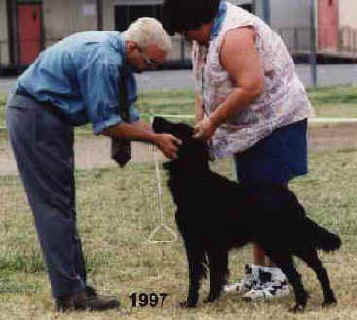|
|
Handling your Flat-Coated Retriever by Bunky Orton
Stacking your dog: Nine times out of ten, the first thing you’ll have to do when you step into the ring is stack your dog. This means that you must manipulate your dog into a certain pose. Throughout the entire process of stacking remain calm, take your time, and always keep the choke chain under your dog’s jaw and behind the ears. The following are the steps you need to take to stack your dog:
Moving your dog (Individual Pattern): Moving your dog can be a pretty tricky thing sometimes because there are many variables. It’s impossible to move your dog the exact same way at every show because the grounds are different, your dog will do many different things, and so will you. Despite all these uncertainties, there are a few guidelines we can follow to ensure that we don’t fall on our butts every time:
Freebaiting: When you return from your pattern, the judge will want to see your dog stand on its own. This is the most unpredictable part of showing your dog. It takes a lot of practice away from the show grounds to get your dog to stack itself. Since most of us have jobs and families to go home to, let’s just get as close as we can. Try these few simple tips:
Moving your dog (Around the Ring): This is a little different than moving in the individual pattern because the judge is looking for something different. On the go-round, the judge wants to see your dog reach and drive as much as it can. In order to show this to the judge properly, you’ve got to move a little faster but still keep control. Most of the steps for moving around the ring are the same as moving in the individual pattern:
At this point in the ring, things can go a million different ways. The judge may make his/her placements right away, or they might go through a series of exercises to narrow down their favorites. Whatever they do, just remember to stay calm, take your time, and follow directions. If there’s something you don’t understand, ask the judge or other exhibitors. Anybody who doesn’t want to help you is a jerk and doesn’t deserve your conversation anyway. Placements (Winners, Losers, and Real Losers): When the judge makes his/her placements, you will fall into one of three categories: The Winners, The Losers, and The Real Losers. The winners are the ones who get ribbons and congratulate everybody. The losers are the ones who don’t get ribbons, but still congratulate everybody. The real losers are the ones who get mad because the judge didn’t like their dog and storm out of the ring. Remember, you paid for one person’s opinion of your dog. Since people are completely unpredictable things, there is no way you could be absolutely certain of the outcome of the show. Don’t get caught up in the petty little games that take place in and out of the ring. Think of dog handling in its simplest definition: The sport of spending time with your best friend. Ribbons come and go; points come and go; handlers, judges, and other exhibitors come and go. The only thing that is permanent is the feeling your dog gets when he/she has done something to please you. Try not to forget that.
Who is Bunky Orton and what does he know about the breed ring? Updated 09/24/98 |
 First of all, NEVER FORGET, that you are in the ring to have fun!! Even
on the crappiest of days, you are outside with your best friend doing something that both
of you can benefit from. You may have a jerk for a judge, you may have run into three
hours of traffic on the way to the show, but no matter what you did before you stepped
into the ring, do your best to make sure that everything that you do while you’re in
the ring is something that makes you smile.
First of all, NEVER FORGET, that you are in the ring to have fun!! Even
on the crappiest of days, you are outside with your best friend doing something that both
of you can benefit from. You may have a jerk for a judge, you may have run into three
hours of traffic on the way to the show, but no matter what you did before you stepped
into the ring, do your best to make sure that everything that you do while you’re in
the ring is something that makes you smile.